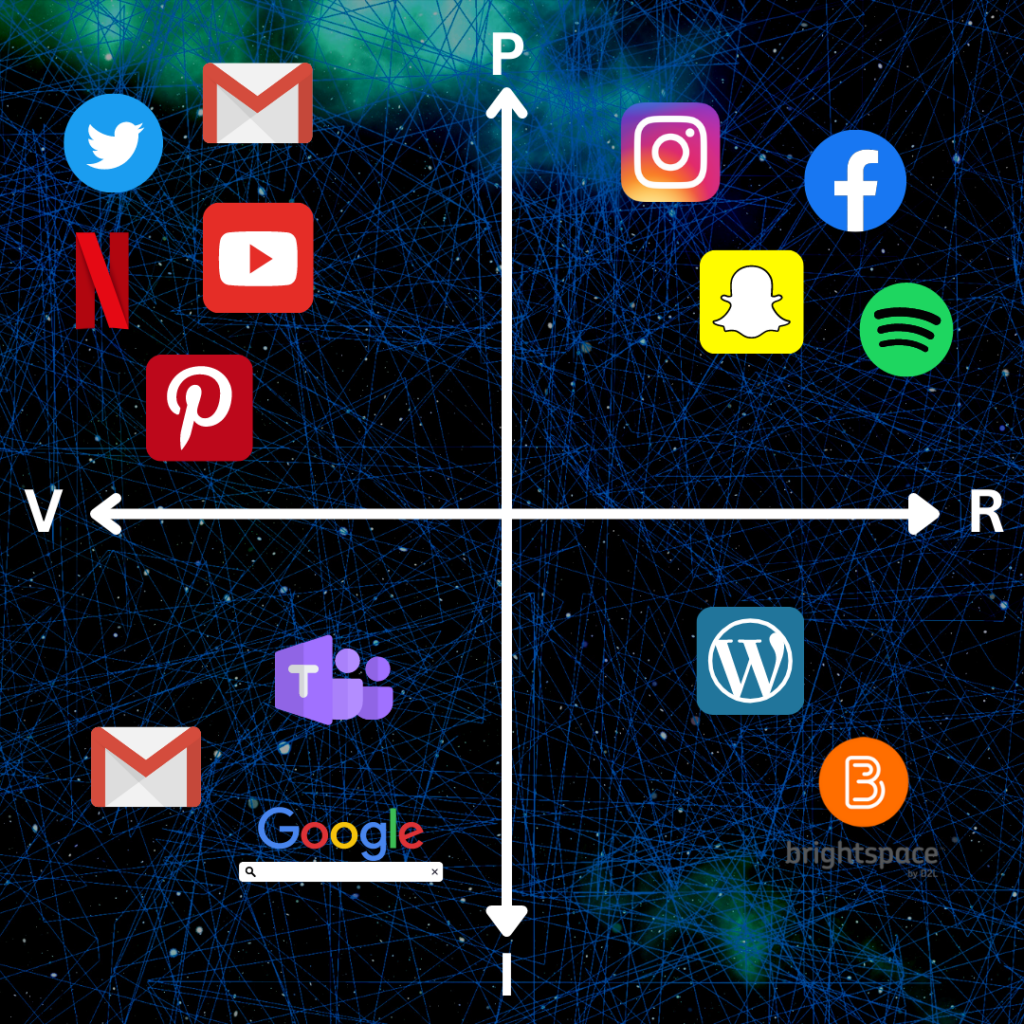What digital platforms are students currently using to develop their professional network?
According to Dixon (2022), Snapchat, TikTok, Instagram, and Twitter are the most used social networks among teens. As a student, I use digital platforms such as Snapchat, Instagram, TikTok, YouTube, and Facebook. When observing my V&R map, I noticed that some digital platforms can overlap for academic and personal reasons. I have a Gmail account to communicate with professors and employers and another Gmail account to register for personal social media accounts. Students may also use Instagram, Snapchat, and Facebook to connect with friends, family, and classmates outside class. I have used Instagram, Snapchat, and Facebook to collaborate with group members for group projects or to talk with people in similar or different programs. This has allowed me to develop my professional network by keeping in touch with people in Psychology. These connections taught me about companies that offer volunteer and work opportunities, which led me to the job I have today. I have also used YouTube to watch YouTubers who are farther into their Psychology program.
What could the student consider in expanding their professional learning network?
- Create an e-portfolio: Students should consider creating an e-portfolio to showcase their professional achievements, which could be on a blog or digital platform. Anders (2018) found that e-portfolios have been effective in academic performance and learning, increasing student self-esteem. This may be because students can reach a greater audience while expanding their PLN.
- Take advantage of social media profiles: Creating a professional social media profile is an excellent way to promote trust, professional brand, and social reputation (Anders, 2018). One way that this can be achieved is through LinkedIn where students can create a personal brand and connect with employers or individuals in the same area of expertise.
- Attend a networking event: Students involved in a networking event can learn from experts in a related field or discover volunteer/career paths. For instance, Psi Chi offers a meet the department event where psychology students can meet faculty and learn about research opportunities. Joining events related to one’s field can open new professional opportunities.
How do data privacy and security limit and/or promote a personal learning network (PLN)
Digital security can limit a personal learning network if our data is not protected. One way this can happen is by connecting to public wifi networks where hackers access our data, financial information, or passwords (Safety in Canada, 2014). WWLP-22News (2015) states students tend to be targeted for identity theft because hackers want a clean credit. Ensuring that we keep our accounts private and safe can prevent confidential information from being shared with hackers and the public. We can stay secure online by having the firewall enabled, and antivirus software is up to date (Safety in Canada, 2014). Data privacy can limit our personal learning networks if we are not careful with what we are posting online, which can affect career opportunities in the future. Although, our data is not always private online, we can use this as an advantage to reach people in our networks by being cautious with what we are sharing.
In your network how can you create a digital identity/reputation?
In my network, I can create a digital identity by first considering what identity I want to appear as online. Once I have an idea of how I want to appear online, I can build a website on WordPress to display my work online and then use social media platforms to reach a greater audience. I can also use my social media accounts to post photos that display how I want my personal brand to be viewed by others. One crucial aspect to consider for creating my digital identity is separating the personal from the professional. The website LinkedIn can be used to develop my professional digital identity, which could lead to career success. Most importantly, I would have to stay active and post regularly to build my digital identity.

How did pivots to work-from-home during the COVID-19 pandemic change how we should consider our social media connectivity and professional balance?
Many of us had to work-from-home because of the COVID-19 pandemic social distancing restrictions. This led everyone to change their ways of connecting with others from offline to online. Digital platforms, such as Facebook, Instagram, Snapchat, Twitter, Zoom, and more, became essential to maintain our socio-emotional connections. This made us more dependent on these platforms for personal, academic, or professional reasons. For instance, 90% of adults state that the internet became more important to them during the pandemic (McClain et al., 2021). Others say that they were using technology and the internet in ways they had never experienced before (McClain et al., 2021). These changes led the public to favour digital technology. For example, adults are now asking schools to provide students with laptops and tablets to complete homework (McClain et al., 2021). Careers are now shifting to video calls for conferences on online platforms, like Zoom. Ultimately, social media connectivity became more crucial after the COVID-19 pandemic in all aspects of our daily life because of its valuable communication tool.
References
Anders, A. D. (2018). Networked learning with professional boosts students’ self-efficacy for social networking and professional development. Computers and Education, 127, 13-29. https//doi.org/10.1016/j.compedu.2018.08.009
Dixon, S. (2022). Favorite social networks of U.S. teens 2012-2021. Statista. https://www.statista.com/statistics/250172/social-network-usage-of-us-teens-and-young-adults/
McClain, C., Vogels, E. A., Perrin, A., Sechopoulos, S., & Rainie, L. (2021). The internet and the pandemic. Pew Research Center. https://www.pewresearch.org/internet/2021/09/01/the-internet-and-the-pandemic/
Safety in Canada. (2014, April 30). Easy Ways to Stay Safe on Public Wi-Fi [Video]. YouTube. https://www.youtube.com/watch?v=X87MJEsJ91A

picpen October 3, 2022
Hi,
I saw you mentioned that our data is not always private and we need to be careful about sharing our information with others. So how do we know that the people we’re sharing information with are safe? Is there any effective method?
Pen
nataly October 17, 2022 — Post author
Hi Pen. Great question! It isn’t easy to keep our information private; however, I believe there are many digital tools that we can use to ensure our data is safer, such as using privacy settings as an advantage on online accounts. This allows users to choose what information they want to keep private or public. One of the videos from this week’s reading mentioned having a secure VPN while browsing online. What are some ways that you keep your data safe online?